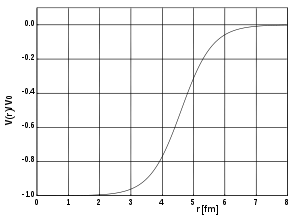Woods–Saxon potential

The Woods–Saxon potential is a mean field potential for the nucleons (protons and neutrons) inside the atomic nucleus, which is used to approximately describe the forces applied on each nucleon, in the shell model for the structure of the nucleus.
The form of the potential, as a function of the distance r from the center of nucleus, is:
where V0 (having dimension of energy) represents the potential well depth, a is a length representing the "surface thickness" of the nucleus, and is the nuclear radius where r0 = 1.25 fm and A is the mass number.
Typical values for the parameters are: V0 ≈ 50 MeV, a ≈ 0.5 fm.
For large atomic number A this potential is similar to a potential well. It has the following desired properties
- It is monotonically increasing with distance, i.e. attracting.
- For large A, it is approximately flat in the center.
- Nucleons near the surface of the nucleus (i.e. having r ≈ R within a distance of order a) experience a large force towards the center.
- It rapidly approaches zero as r goes to infinity (r − R >> a), reflecting the short-distance nature of the strong nuclear force.
When using the Schrödinger equation to find the energy levels of nucleons subjected to the Woods–Saxon potential, it cannot be solved analytically, and must be treated numerically.
See also
- Finite potential well
- Quantum harmonic oscillator
- Particle in a box
- Yukawa potential
- Nuclear force
- Nuclear structure
- Shell model
- David S. Saxon
References
- Woods, R.D.; Saxon, D.S. (1954). "Diffuse Surface Optical Model for Nucleon-Nuclei Scattering". Physical Review. 95 (2): 577–578. Bibcode:1954PhRv...95..577W. doi:10.1103/PhysRev.95.577.
- Schwierz, N.; Wiedenhover, I.; Volya, A. (2007). "Parameterization of the Woods-Saxon Potential for Shell-Model Calculations". arXiv:0709.3525
 [nucl-th].
[nucl-th].